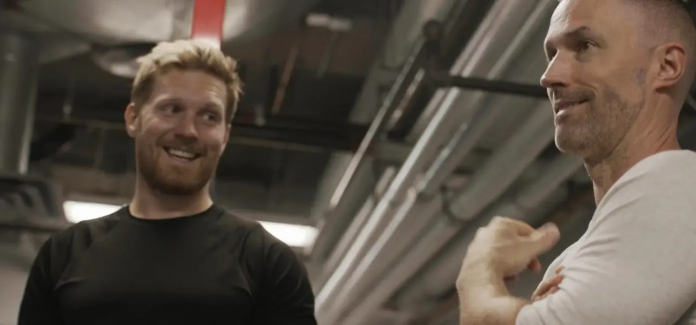 Courtesy of FreshTape Media
Courtesy of FreshTape Media
Gabe Landeskog, left, and Matthew Jordan.
Kaiden Brayshaw
Local Journalism Initiative Reporter
LiveWire Calgary
As Calgarians sit on the edge of their seats awaiting Flames’ 8 p.m. season opener against the Edmonton Oilers, the most diehard fans might have tuned into the Colorado Avalanche vs Los Angeles Kings Tuesday night game.
The game, a 4-1 Avalanche win, was not only the NHL’s third game of the year, it was also Avalanche captain Gabriel Landeskog’s first regular season game in more than three years.
After captaining his team to a 2022 Stanley Cup win, Landeskog missed three full regular seasons and had multiple surgeries, including a cartilage transplant in 2023, because of a knee injury.
The nature of Landeskog’s injury left one UCalgary prof oddly qualified to advise in his recovery.
“The problem was that Gabe (Landeskog) had sustained an incredibly severe cartilage injury consequent to what we believe was a skate cut that he sustained,” said UCalgary Assistant Professor Matthew Jordan.
“Subsequent to that, he essentially wore a hole in the back of his cartilage, which would be akin to putting your fist through drywall, if you imagine it leaves a big hole and that needs to be patched.”
After being asked to help with the recovery by another of Landeskog’s manual therapists, Jordan knew that his niche expertise came into play perfectly when dealing with this specific injury.
“In my previous work as a head of sports science and sport medicine for Alpine Canada, skiers injuries are typically very, very traumatic, as they get the same sorts of cartilage injuries. So I had some experience with individuals who had had this type of surgery, and I had some understanding of what the trajectory would look like,” he said.
Typically with these severe cartilage injuries, athletes’ timelines to get back to sport is not measured in months, it is measured in years, Jordan said. Once the “drywall” of Landeskog’s leg was fixed, a long process including physical therapy was ahead of the athlete.
“There’s a whole journey to be able to get back to walking normally, getting up the stairs, moving around with your kids, let alone being able to get into an NHL game in the playoffs,” he said.
Typically, in-lab analysis and diagnosis of injuries is similar to bringing your vehicle to an auto-body shop, where they attach your car to a computer and diagnose problems, Jordan said.
“But the problem is still that when they leave that high-care environment of a clinic or a training space and they’re now back out on the field of play or the ice, we have very low visibility on their movements and their biomechanics, which are intimately linked to their recovery and function.”
Enter Plantiga.
Sensor measures every step
Nearly a decade after being first approached by the Plantiga’s CEO to co-develop a real-world applicable biomechanical sensor, Jordan was able to use technology he helped build to rehabilitate the NHL all-star and Stanley Cup champion.
“We’ve developed essentially the only validated, in-shoe sensor technology, It’s used by professional athletes from all kinds of different sports, used in clinics and in research.
The Plantiga chip automatically detects when the wearer is running, walking and jumping, and analyzes accordingly.
“We used this with Gabe extensively, to essentially monitor his every step, no pun intended,” Jordan said.
Daily, when Landeskog was in Colorado, he’d go for a morning walk. Immediately afterwards, Jordan and another one of his trainers would analyze the date from the walk and based on his walk patterns.
“We would look at his biomechanics and we would make an appraisal based on whether that day was a green light day, ‘let’s go for it,’ a yellow light day, ‘maybe we pull back a little bit,’ or we’d sort of reached the limit of what his knee could take, at which point we would begin our recovery cycle and allow him to rebuild and recover as we prep for the next day,” Jordan said.
“Everything was very, very calculated.”
Through the Plantiga chip, Landeskog’s trainers, including Jordan, were able to understand the mechanical load that a knee is under during a typical NHL game and reverse engineer where Landeskog was and where he needed to get to.
Around December of 2024, Jordan said the team began to see the recovery turning a corner. When progress continued into January and February, the team knew Landeskog was on the cusp of a long awaited NHL return.
After playing two games with the Avalanche’s minor league affiliate, the Colorado Eagles, Landeskog was set to return to the Avalanche lineup during the 2025 Stanley Cup Playoffs, 1,032 days in the making.
“For his comeback game, it was really critical for him to have his friends and family there and I was very fortunate that Gabe saw me as part of that team of people who helped him,” Jordan said.
“It was Ball arena, game three against Dallas (Stars) and Gabe flew us all down and put us up in a hotel and got us some seats and we joined his friends and family, it was awesome.”
After ups and downs, seeing Landeskog play was amazing for Jordan.
“He played a great game and the crowd was electric,” he said.
“It was a really beautiful moment.”
Landeskog finished the series with a goal and three assists. He is now set to help the team chase its fourth Stanley Cup victory.


